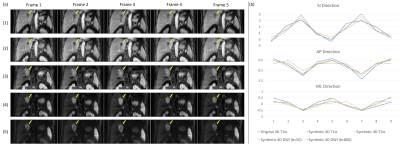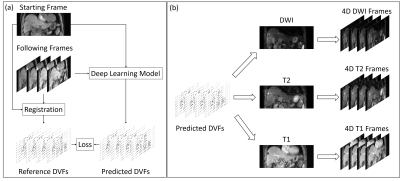Haonan Xiao1, Tian Li1, Jiang Zhang1, Ruiyan Ni1, Ge Ren1, Yibao Zhang2, Weiwei Liu2, Weihu Wang2, Hao Wu2, Victor Lee3, Andy Cheung3, Hing-Chiu Chang3, and Jing Cai1
1The Hong Kong Polytechnic University, Hong Kong, China, 2Key Laboratory of Carcinogenesis and Translational Research (Ministry of Education/Beijing), Department of Radiation Oncology, Peking University Cancer Hospital & Institute, Beijing, China, 3The University of Hong Kong, Hong Kong, China
1The Hong Kong Polytechnic University, Hong Kong, China, 2Key Laboratory of Carcinogenesis and Translational Research (Ministry of Education/Beijing), Department of Radiation Oncology, Peking University Cancer Hospital & Institute, Beijing, China, 3The University of Hong Kong, Hong Kong, China
The synthetic
ultra-quality 4D-MRIs showed accurate tumor
motion trajectory with significantly improved image quality than the
traditional 4D-MRI.

Figure 2:
(a) Visual comparison between (1) original 4D MR,
(2) synthetic 4D T1w, (3) synthetic 4D T2w, (4) synthetic 4D DWI (b=50), and
(5) synthetic 4D DWI (b=800) images. Tumors were indicated by the yellow arrows.
(b) Tumor motion during 2 respiratory cycles in superior-inferior (SI),
anterior-posterior (AP), and mid-lateral (ML) direction measured from different
4D-MRIs. Synthetic 4D-MRIs overall showed a well-matched tumor motion with the
original T1w 4D-MRI.

Figure 1: (a) Training:
reference DVFs were calculated between the starting frame and following frames and predicted DVFs were generated from the DL model with the two frames as
inputs. The training loss was defined as the difference between the two sets of
DVFs. (b) Application: appropriate starting frames were registered to other
frames using the DL model, and the predicted DVFs warped the 3D MRIs to
generate MRI frames at corresponding respiratory phases.